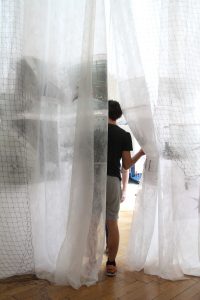
Spatial memory is a term often used to describe the neurological process of recalling where something happened or where an object was placed. This type of memory is also used to project into the future, to plan a route to a desired location.
It is hard to consider spatial memory without invoking a poetic light. What is this intangible part of us that is tied to places and our memories of them? How is it that we can still recall the layout of a childhood home despite not having stepped foot in it in years?
The themes of the “Tread Softly” exhibit included “the city, migration, and memory”. The title is an allusion to the W.B. Yeats poem, “The Cloths of Heaven”, where he writes, “Tread softly because you tread on my dreams.” [*1] It considered how the cities we live in become the space in which we operate, tenderly attending to ideas of spatial memories, among others.
The opening of the exhibit at the BOX Freiraum in October was the second time the BCB student works featured there were on display. The first was at the end of the previous academic year, in May, in the context of “The Impossible Order” conference (click here for an overview of the conference and a review of Panel VII).
The installation in which the BCB student exhibits were embedded was designed and built by students of Art and Architecture from the Academy of Fine Arts in Vienna. The walkway was shrouded in gauzy white fabric. Our first impression stepping into it was that the exhibit looked like a ransacked home: haphazard curtains, scrambled furniture, matryoshkas, a TV in front of a wooden couch, a makeshift living room, a potted fern. The gallery itself invoked a memory of migration. It seemed as if someone rushed through a house, took what they could, and left the rest as bare bones. Only objects remained, like tangible pieces of “home” reaching out to us from the past.
The pieces spoke to both private, personal issues and political issues at large. As the curators describe on the website, “Responding to the challenge of finding transitory, adaptable, disappearing and reappearing architectures, [the exhibit] seeks neither to master nor to serve the individual embedded pieces, but to enter into dialogue with them.” [*2] Within these pointed and individual experiences, a wider dialogue arose, connecting themes of migration and relationships to urban spaces.
Indeed, a continual dialogue is what led to the creation of the exhibit in the first place. What began as a class in German migration history in the Fall semester of 2016 bled into a workshop class in “Creation Research” in the Spring semester of 2016, where the projects conceived of in the fall were made manifest through a collaborative effort. There was no end goal in mind; process was premium, and the course an experiment conducted in good faith.
In a particularly striking video by BCB student Wafa Mustafa, the narrator wanders through the Berlin Holocaust Memorial, entranced by the story of Malka, a Polish-Jewish girl killed in the Holocaust. The memorial here is the material embodiment of spatial memory — a space that evokes memory. Tragedy and memory unfold simultaneously in and through space, through spatiality. Here, two stories of refuge, of forced migration, emerge as the viewer is walked through the haunting blocks of the Holocaust Memorial. This is a simulacrum, the evocation of memory by moving through a space.
The video and the gallery thus operate through space production, through spaces that emerged from pre-existing ones. The space that is explored in Wafa’s video becomes the vessel through which the artist’s memories of refuge are confronted. Similarly, the gallery space becomes the combination, the unity, of the memorializing of each piece. These are the strengths of a collaboration gleaned from so many sources.
We approached the nesting doll in the corner. This matryoshka was a collaborative piece that invited visitors to insert their questions on small slips of paper:
“What connects us to the idea/concept of ‘home’?”
“Do you feel the need to call a place home?”
“What kind of memories/identity have I lost access to from the branches of my family who are lost in time?”
“How does the memory of migration live within objects?”
“What does one leave behind if they think they’re coming back?”
Though there is no “right” answer to these questions, the strength of the exhibit lay in its ability to pose them from differing vantage points and using diverse artistic media. And it was with these questions in mind that we left the BOX freiraum — more aware of the space around us, the spatial memories we’re tacitly building, and the objects that make a place feel like home.
Notes:
- https://www.wolfson.ox.ac.uk/~ben/writings/TheClothsofHeaven.html
- http://www.berlin.bard.edu/news/view/archive/2017/october/article/exhibition-and-student-conversation-itread-softly-the-city-migration-and-memoryi/
